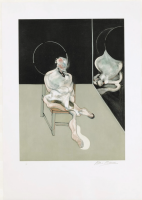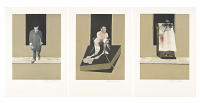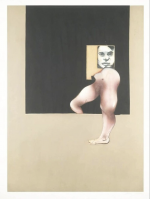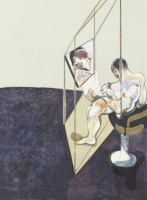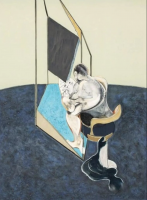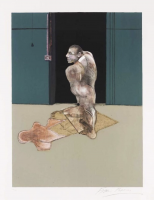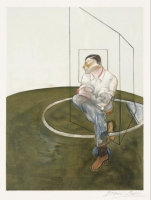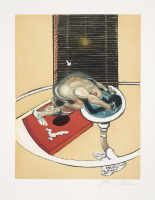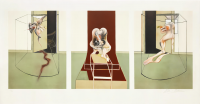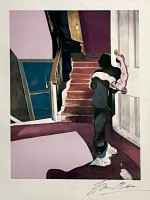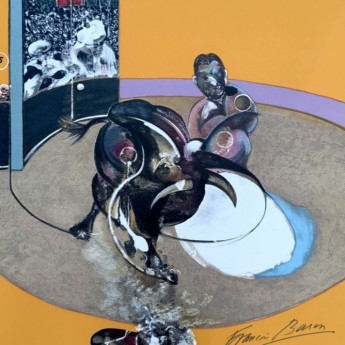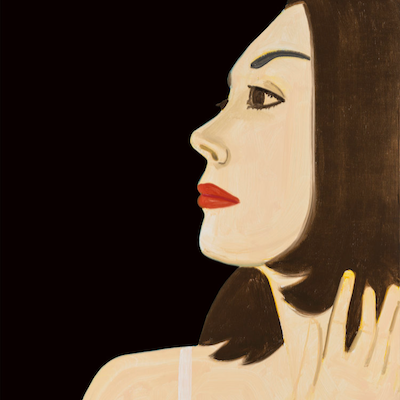
Details
Artist
Styles
Three etchings and aquatints printed in colors on one sheet of Guarro wove paper, 1981 - Dimensions: - Image size (3x): 39.0 x 29.7 cm - Paper size: 62.8 x 110.2 cm - Signed in pencil (lower right) - Catalogue raisonné: - Bruno Sabatier no. 4 - Alexandre Tacou no. 13 // Francis Bacon's Triptych (1974-1977) is a haunting and powerful work presented as three etchings and aquatints printed in color on a single sheet of Guarro wove paper. The composition reflects Bacon's signature exploration of the human form, distortion, and psychological intensity. The central image features a solitary, twisted figure in the foreground, surrounded by dark, looming shapes in the background. The left and right panels depict similar contorted figures reclining under black umbrellas, set against an isolated, surreal seascape. The subtle yet eerie color palette of muted greens, blues, and grays enhances the unsettling nature of the work. The figures appear both vulnerable and confined, locked in postures of anguish and alienation. Bacon's work is known for its raw emotional power and his ability to depict the complexity of human suffering and existence. This print is signed by Bacon in pencil at the lower right and belongs to a limited edition of 99. The work appears in the catalogues of Bruno Sabatier (no. 4) and Alexandre Tacou (no. 13), underscoring its significance in Bacon’s oeuvre.
Triptych, 1974-1977
form
Medium
Size
62.8 x 110.2 cm
- Inches
- Centimeters
Edition
Price
Details
Artist
Styles
Three etchings and aquatints printed in colors on one sheet of Guarro wove paper, 1981 - Dimensions: - Image size (3x): 39.0 x 29.7 cm - Paper size: 62.8 x 110.2 cm - Signed in pencil (lower right) - Catalogue raisonné: - Bruno Sabatier no. 4 - Alexandre Tacou no. 13 // Francis Bacon's Triptych (1974-1977) is a haunting and powerful work presented as three etchings and aquatints printed in color on a single sheet of Guarro wove paper. The composition reflects Bacon's signature exploration of the human form, distortion, and psychological intensity. The central image features a solitary, twisted figure in the foreground, surrounded by dark, looming shapes in the background. The left and right panels depict similar contorted figures reclining under black umbrellas, set against an isolated, surreal seascape. The subtle yet eerie color palette of muted greens, blues, and grays enhances the unsettling nature of the work. The figures appear both vulnerable and confined, locked in postures of anguish and alienation. Bacon's work is known for its raw emotional power and his ability to depict the complexity of human suffering and existence. This print is signed by Bacon in pencil at the lower right and belongs to a limited edition of 99. The work appears in the catalogues of Bruno Sabatier (no. 4) and Alexandre Tacou (no. 13), underscoring its significance in Bacon’s oeuvre.
- Recently Added
- Price (low-high )
- Price (high-low )
- Year (low-high )
- Year (high-low )
Francis Bacon
Three Studies Of Male Back (One Work - Right Hand Panel Of The Triptych), 1987
Limited Edition Print
Lithograph
Inquire For Price
Francis Bacon
Three Studies Of Male Back (One Work - Central Panel Of The Triptych), 1987
Limited Edition Print
Lithograph
GBP 18,000 - 22,000
Francis Bacon
Study For A Portrait Of John Edwards (s.9495), 1986
Limited Edition Print
Lithograph
GBP 17,000 - 20,000
Francis Bacon
Study For A Portrait Of John Edwards, 1988
Limited Edition Print
Lithograph
GBP 18,000 - 25,000
Francis Bacon
L’Homme Au Lavabo Figure At A Washbasin, 1978
Limited Edition Print
Etching And Aquatint
GBP 19,000 - 23,000
Francis Bacon
Triptych, March 1974 ( Centre Panel ), 1978
Limited Edition Print
Offset Print
EUR 15,450
Francis Bacon
Study For Portrait Of Pope Innocent X After Velasquez, 1989
Limited Edition Print
Lithograph
EUR 60,000 - 70,000
Francis Bacon
Three Studies For A Portrait Of John Edwards, 1980
Limited Edition Print
Lithograph
EUR 57,000 - 70,000
Francis Bacon
Triptych Inspired By Oresteia Of Aeschylus (s.9503), 1981
Limited Edition Print
Lithograph
Currently Not Available
Francis Bacon
Triptych, 1974-1977
Limited Edition Print
Etching And Aquatint
Currently Not Available
What is figurative art?
Sometimes known as Figurativism, figurative art refers to sculptures and paintings that are clearly or specifically derived from real objects, making them representational. The term figurative art is often used in contrast to abstract art. However, since the emergence of abstract art, figurative art has come to describe any form of modern art that has strong references to the real world or actual situations.



